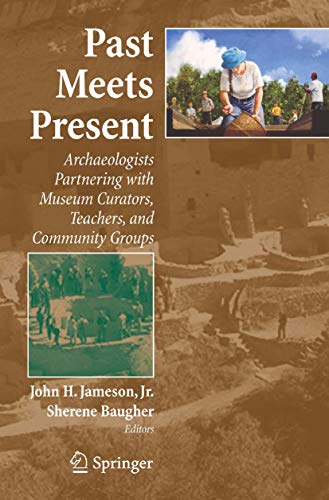Items related to Past Meets Present: Archaeologists Partnering with...
Past Meets Present: Archaeologists Partnering with Museum Curators, Teachers, and Community Groups - Softcover

Synopsis
In the face of an increasing public interest and demand for information, archaeologists are starting to collaborate with historians, educators, interpreters, museum curators, exhibit designers, landscape architects, and other cultural resource specialists to devise the best strategies for translating an explosion of archaeological information for the public. In turn, some communities are partnering with archaeologists to become active players in the excavation, interpretation, and preservation of their heritage.
The last decade has witnessed numerous applications of public interpretation and outreach models and an increased interest in establishing partnerships between professional practitioners in public interpretation and educational institutions such as museums and schools. These developments have occurred in the context of a realization that community-based partnerships are the most effective mechanism for long-term success. It is clear that there is a need for a volume that addresses these latest trends and provides case studies of successful partnerships.
"synopsis" may belong to another edition of this title.
From the Back Cover
In these times of decreasing funding to humanities and social sciences, program directors are reluctant to undertake outreach projects that they assume require large budgets. The selected case studies in Past Meets Present, however, reflect modest start-up costs, demonstrating that success need not be tied to big bank rolls. The lesson to be derived from these modestly funded projects is that peoples’ attitudes and initiatives make the difference. Focusing on a broad range of successful public archaeological programs in schools and local communities, this book addresses a wide range of developments and standards for effective public interpretation, education, and outreach in archaeology.
Past Meets Present provides the reader with models for implementing public outreach programs with an emphasis on collaborative partnerships. Only when archaeologists are willing to reach out to people in other professions and work with and learn from the community can successful partnerships be formed. Past Meets Present describes effective models of collaboration that enable the archaeology of the past to meet the educational and interpretive needs of the present.
Cover photo courtesy of John H. Jameson, Jr. and the painting "Unlocking the Past" by Martin Pate is courtesy of the Southeast Archaeological Center, National Park Service.
"About this title" may belong to another edition of this title.
Search results for Past Meets Present: Archaeologists Partnering with...
Past Meets Present: Archaeologists Partnering with Museum Curators, Teachers, and Community Groups
Seller: Best Price, Torrance, CA, U.S.A.
Condition: New. SUPER FAST SHIPPING. Seller Inventory # 9780387769806
Quantity: 2 available
Past Meets Present: Archaeologists Partnering with Museum Curators, Teachers, and Community Groups
Seller: Lucky's Textbooks, Dallas, TX, U.S.A.
Condition: New. Seller Inventory # ABLIING23Feb2215580173126
Quantity: Over 20 available
Past Meets Present: Archaeologists Partnering with Museum Curators, Teachers, and Community Groups
Seller: Ria Christie Collections, Uxbridge, United Kingdom
Condition: New. In. Seller Inventory # ria9780387769806_new
Quantity: Over 20 available
Past Meets Present : Archaeologists Partnering with Museum Curators, Teachers, and Community Groups
Seller: Chiron Media, Wallingford, United Kingdom
PF. Condition: New. Seller Inventory # 6666-IUK-9780387769806
Quantity: 10 available
Past Meets Present: Archaeologists Partnering with Museum Curators, Teachers, and Community Groups
Seller: THE SAINT BOOKSTORE, Southport, United Kingdom
Paperback / softback. Condition: New. This item is printed on demand. New copy - Usually dispatched within 5-9 working days 711. Seller Inventory # C9780387769806
Quantity: Over 20 available
Past Meets Present: Archaeologists Partnering with Museum Curators, Teachers, and Community Groups
Seller: moluna, Greven, Germany
Kartoniert / Broschiert. Condition: New. Dieser Artikel ist ein Print on Demand Artikel und wird nach Ihrer Bestellung fuer Sie gedruckt. Brings together cases of public interpretation of cultural heritageOnly a few publications (one by the co-editor Jameson) on public interpretation of archaeologyThe contributors are international representing the UK, Australia, Canada as we. Seller Inventory # 458430585
Quantity: Over 20 available

